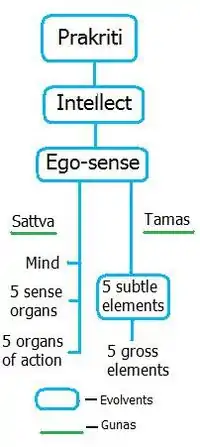سامخيا
سامخيا (باللغة السنسكريتية: सांख्य|सांख्य) هي إحدى مدارس الأستيكا (الوجودية) الستة في الفلسفة الهندية،[1][2][3] وتوصف على أنها المدرسة العقلانية في تلك الفلسفة.[4] ترتبط السامخيا بشكل كبير بمدرسة فلسفة اليوغا في الهندوسية، وكان لواقعيتها تأثير على مدراس أخرى في الفلسفة الهندية.[5]

| جزء من سلسلة مقالات عن |
| الهندوسية |
|---|
 |
| بوابة هندوسية |
السامخيا عبارة عن فلسفة تقوم نظرية المعرفة فيها على القبول بثلاثة دلائل (برامانا pramana) من أصل ستة كطرق للحصول على المعرفة، وهي pratyakṣa الإدراك وanumāṇa الاستنباط أو الاستدلال وśabda الاستشهاد بمصادر موثوقة.[6][7][8]
تنتمي فلسفة السامخيا إلى مذهب الثنائية الفلسفي،[9][10][11] إذ تعتبر السامخيا أن الكون يتألف من واقعين اثنين؛ الأول بوروشا Purusha (الوعي أو العقل) والثاني براكريتي Prakṛti (الطبيعة أو المادة).
المراجع
- Knut Jacobsen, Theory and Practice of Yoga, Motilal Banarsidass, ISBN 978-81-208-3232-9, pages 100-101
- "Samkhya", American Heritage Dictionary of the English Language, Fifth Edition (2011), Quote: "Samkhya is a system of Hindu philosophy based on a dualism involving the ultimate principles of soul and matter."
-
"Samkhya", Webster’s College Dictionary (2010), Random House, ISBN 978-0-375-40741-3, Quote: "Samkhya is a system of Hindu philosophy stressing the reality and duality of spirit and matter." - Mike Burley (2012), Classical Samkhya and Yoga - An Indian Metaphysics of Experience, Routledge, ISBN 978-0-415-64887-5, pages 43-46
- Roy Perrett, Indian Ethics: Classical traditions and contemporary challenges, Volume 1 (Editor: P Bilimoria et al), Ashgate, ISBN 978-0-7546-3301-3, pages 149-158
- Larson 1998، صفحة 9
-
- Eliott Deutsche (2000), in Philosophy of Religion : Indian Philosophy Vol 4 (Editor: Roy Perrett), Routledge, ISBN 978-0-8153-3611-2, pages 245-248;
- John A. Grimes, A Concise Dictionary of Indian Philosophy: Sanskrit Terms Defined in English, State University of New York Press, ISBN 978-0-7914-3067-5, page 238
- John A. Grimes, A Concise Dictionary of Indian Philosophy: Sanskrit Terms Defined in English, State University of New York Press, ISBN 978-0-7914-3067-5, page 238
- Michaels 2004، صفحة 264
- Sen Gupta 1986، صفحة 6
- Radhakrishnan & Moore 1957، صفحة 89
- بوابة الروحانية
- بوابة الهندوسية
- بوابة الأديان
- بوابة إلحاد
This article is issued from Wikipedia. The text is licensed under Creative Commons - Attribution - Sharealike. Additional terms may apply for the media files.
